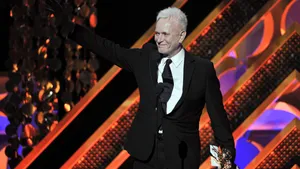Few topics are as controversial as the meaning of the gender binary within trans communities. But a new documentary seeks to find the balance in -- and beyond -- the binary.
"I'm a transsexual man. But I'm also very gender-fluid and very androgynous," says Matty Boi at the beginning of Identity: In & Beyond The Binary, the new film by Ninfa and AVN-award-winning Los Angeles photographer Dave Naz. "I feel like I've always kind of been in the middle. But I've always identified with a male pronoun."
Boi's self-identification mirrors that of another trans man profiled in Identity, named Wolfe Moon.
"I knew like around 7, something was really off, when I started standing up to pee in the toilet," says Moon. "I don't have any brothers. I'm the oldest of four children and my mom caught me and she kind of freaked out."
"I want to talk about being trans, and honestly, I don't necessarily identify as a trans person," explains Buck Angel, the longtime sex educator and sex-positive model and actor. "I do identify more as a male,"
Boi, Moon, and Angel -- along with 33 other gender-variant people interviewed for the film -- highlight the many ways trans people self-identity within (and without) prevailing definitions of what it means to be a man or a woman. These definitions -- the societal expectations of how a man or a woman should look, sound, and behave -- are known as the gender binary.
By presenting the first-person accounts of people who have medically transitioned (with hormones or surgery) alongside those of people who identify as non-binary, the film spotlights the richness -- and the controversy -- of trans identities.
"If you look at all of the people who I interviewed, there's a lot of diversity," Naz tells The Advocate. "What they say keeps expanding what trans means."
Naz is a the son of Maxine F. Nazworthy, a descendant of the pioneering makeup guru Max Factor, and a longtime trans ally. He is also a cisgender (nontrans) man who is married to the adult film actress Oriana Small, also known as Ashley Blue.
Naz says his photography and video is inspired by artists like Diane Arbus, Nan Goldin, and Larry Clark, whose work investigates the lives of people who transgress societal norms. Naz's work has been exhibited at Los Angeles galleries Coagula Curatorial and Perihelion, and Identity premiered in 2015 at the University of Redlands Art Gallery.
Some of those profiled in Identity were also photographed for Naz's book Genderqueer And Other Gender Identities, with images that debuted in The Advocate last year. Naz aims to be a champion of positive images of sexual pleasure and frank depictions of consensual sexual freedom.
"The best part of the film is that all of [the subjects] get to talk from their heart about who they are and how they identify," says Naz unequivocally.
Identity takes a hopeful, cinematic approach. Shot in a straightforward, plain style where each subject speaks directly to the camera about how they formed their sense of self, the profiles of Identity's subjects are unsparingly honest. The raw nakedness of this testimony reveals that gender-variant people often do not fit neatly into easily defined categories. Frequently, the subjects use pronouns and phrases that reflect their trans identity, at the same time that they embrace a range of masculine and feminine gender expressions.
The subjects are also candid about the often-harsh reality that defies the privilege and relative safety enjoyed by high-profile celebrities like Caitlyn Jenner.
In one eye-opening scene, Jonelle Brooks and others talk frankly about taking hormones. One trans woman (whose name is not disclosed) shares the challenges of trying to maintain a hormone regimen without steady health insurance.
Departing from the sit-down interviews that dominate most of the film, the camera follows this trans woman into the bathroom as she cracks the top off a vial of non-prescription hormones she acquired online. She learned how to inject the medication through the advice of friends. She falls back on advice she recieved from a doctor she visited when she had insurance.
These scenes offer an unprecedented, empathetic window into the reality of trans medical transition. The subjects speak openly about how necessary the medication is to their wellbeing. At the same time, the struggles they candidly share expose the long road ahead until government and health providers make access to such medically necessary treatment safe, consistent, and affordable.
Watch the entire film, exclusively, below.




































































Charlie Kirk DID say stoning gay people was the 'perfect law' — and these other heinous quotes